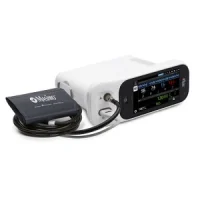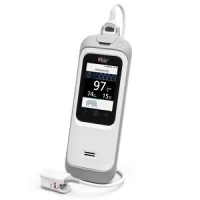Masimo has announced the publication of a recent study conducted on adult patients undergoing liver transplantation (LT), in which researchers assessed the accuracy and trending ability of noninvasive Masimo SpHb® (total hemoglobin) measurement, as compared to conventional laboratory hemoglobin (HbL) measurements. The researchers found that SpHb had "clinically acceptable accuracy of hemoglobin measurement [compared] with a standard laboratory device when used during LT" and that "[t]his technology can be useful as a trend monitor during all surgical phases of LT and can supplement HbL to optimize transfusion decisions or to detect occult bleeding."1
Monitoring a patient's hemoglobin (Hb) levels is essential during LT because, as the researchers point out, "a serious loss of blood and fluid shift causes great variations [in] the Hb level, and delayed blood transfusion may cause graft dysfunction because of hypo-perfusion and tissue hypoxia. Moreover, more importantly, over-transfusion is associated with end organ damage and graft dysfunction." Recognizing that the "benefits and clinical advantages of noninvasive, rapid, and accurate determination of Hb in the operating room are obvious," Dr. Kayhan and colleagues sought to evaluate the accuracy and trending ability of Masimo SpHb during LT by comparing its measurements to those of a standard laboratory hematology analyzer.
To this end, the investigators enrolled fifty-five adult patients undergoing orthotopic LT in the study. The patients' Hb levels were analyzed using a Beckman Coulter LH 780 Hematology Analyzer, with each patient's arterial blood being sampled six times, twice during each of the three phases of the surgery: pre-anhepatic, anhepatic, and neohepatic. SpHb values were recorded within 10 seconds of each blood sample using a Masimo Radical-7® Pulse CO-Oximeter® (software version 7.8.0.1) and Masimo rainbow®ReSposable R2-25r and R2-25a sensors. A total of 282 paired measurements were collected and analyzed. HbL values ranged from 5.4 to 17.1 g/dL (mean 10.58) and SpHb values ranged from 6.9 to 17.7 g/dL (mean 11.44).
To compare the accuracies of the two methods, the researchers used a Bland-Altman plot and calculated absolute bias (the differences between SpHb and HbL) of 0.86 (95% CI = 0.50-1.21), precision (one standard deviation of the bias) of 1.58, and limits of agreement of -2.25 to 3.96. Using Pearson's correlation analysis, the researchers found that the correlation between the two sets of values was "highly significant": Pearson's correlation coefficient r=0.73; 95% confidence interval = 0.67-0.78, R2=0.53, p less than 0.001.
The researchers concluded that "[t]he results of this study show that SpHb has clinically acceptable accuracy of Hb measurement as compared with a standard laboratory device when used during LT. This technology may provide more timely information on Hb status than intermittent blood sample analysis and thus has the potential to improve blood management during LT. The trending accuracy may not only detect occult bleeding but can also prevent over-transfusion after bleeding; at least this method has the potential to supplement detection of changes. Nevertheless, due to underestimation in the lower Hb values, clinicians should be cautious when making decisions based on SpHb alone. Instead of focusing on a single value, SpHb may be considered an early warning system and a trend monitor. Future studies should evaluate the utility of SpHb in terms of overall clinical outcomes of transfusion decision."
"In prior studies using SpHb monitoring, reductions in blood transfusion were observed,2,3,4 and when used with PVi®, another Masimo noninvasive measurement, a reduction in 30-day mortality was observed5," stated Joe Kiani, Founder and CEO of Masimo. "Dr. Kayhan's study adds to the evidence that SpHb may be a useful tool during procedures such as liver transplantation."
SpHb monitoring may provide additional insight to the directional trend of hemoglobin between invasive blood samples. SpHb monitoring is intended to supplement, not replace, laboratory measurements. Blood samples should be analyzed by laboratory instruments when possible prior to clinical decision making.
References
1. Kayhan et al. Accuracy of Noninvasive Hemoglobin Monitoring by Pulse CO-Oximeter During Liver Transplantation. Minerva Anestesiologica. 2017 Jan 20. DOI: 10.23736/S0375-9393.17.11652-4
2. Ehrenfeld JM et al. Continuous Non-invasive Hemoglobin Monitoring during Orthopedia Surgery: A Randomized Trial. J Blood Disorders Transf. 2014. 5:9. 2.
3. Awada WN et al. Continuous and noninvasive hemoglobin monitoring reduces red blood cell transfusion during neurosurgery: a prospective cohort study. J Clin Monit Comput. 2015 Feb 4.
4. Imaizumi et al. Continuous and noninvasive hemoglobin monitoring may reduce excessive intraoperative RBC transfusion. Proceedings from the 16th World Congress of Anaesthesiologists, Hong Kong, 2016. Abstract #PR607.
5. Nathan N et al. Impact of Continuous Perioperative SpHb Monitoring. Proceedings from the 2016 ASA Annual Meeting, Chicago. Abstract #A1103.
Source & Image Credit: Masimo










